KRAS mutations in the parental tumour accelerate in vitro growth of tumoroids established from colorectal adenocarcinoma
- PMID: 30884019
- PMCID: PMC6463397
- DOI: 10.1111/iep.12308
KRAS mutations in the parental tumour accelerate in vitro growth of tumoroids established from colorectal adenocarcinoma
Abstract
The aim of the present study was to characterize a patient-derived in vitro 3D model (ie tumoroid) established from colorectal adenocarcinoma. This study investigated the growth rate of tumoroids and whether the Kirsten rat sarcoma (KRAS) mutations in the parental tumour accelerate this rate. The tumoroids were established from surgical resections of primary and metastatic colorectal adenocarcinoma from 26 patients. The in vitro growth rate of these tumoroids was monitored by automated imaging and recorded as relative growth rate. The KRAS hotspot mutations were investigated on the parental tumours by Ion Torrent™ next-generation sequencing. The KRAS mutations were detected in 58% of the parental tumours, and a significantly higher growth rate was observed for tumoroids established from the KRAS-mutated tumours compared to wild-type tumours (P < 0.0001). The average relative growth rate (log10) on day 10 was 0.360 ± 0.180 (mean ± SD) for the KRAS-mutated group and 0.098 ± 0.135 (mean ± SD) for the KRAS wild-type group. These results showed that the presence of KRAS mutations in parental tumours is associated with an acceleration of the growth rate of tumoroids. The future perspective for such a model could be the implementation of chemoassays for personalized medicine.
Keywords: 3D in vitro culture; Kirsten rat sarcoma mutation; colorectal cancer; gastrointestinal pathology; tumoroids.
© 2019 The Authors. International Journal of Experimental Pathology © 2019 International Journal of Experimental Pathology.
Conflict of interest statement
The authors declare no conflict of interests.
Figures


Similar articles
-
The density of infiltrating T cells and macrophages in the parental tumour correlates with growth rate of tumoroids established from colorectal adenocarcinoma.Int J Exp Pathol. 2019 Oct;100(5-6):304-310. doi: 10.1111/iep.12341. Epub 2020 Jan 29. Int J Exp Pathol. 2019. PMID: 31997501 Free PMC article.
-
Characterization of in vitro 3D cultures.APMIS. 2021 Aug;129 Suppl 142:1-30. doi: 10.1111/apm.13168. APMIS. 2021. PMID: 34399444
-
KRAS and BRAF mutation analysis can be reliably performed on aspirated cytological specimens of metastatic colorectal carcinoma.Cytopathology. 2011 Dec;22(6):358-64. doi: 10.1111/j.1365-2303.2010.00812.x. Epub 2010 Oct 4. Cytopathology. 2011. PMID: 21029218
-
Strategies to target energy metabolism in consensus molecular subtype 3 along with Kirsten rat sarcoma viral oncogene homolog mutations for colorectal cancer therapy.J Cell Physiol. 2019 May;234(5):5601-5612. doi: 10.1002/jcp.27388. Epub 2018 Oct 20. J Cell Physiol. 2019. PMID: 30341899 Review.
-
Current Advances and Trends in KRAS Targeted Therapies for Colorectal Cancer.Mol Cancer Res. 2022 Jan;20(1):30-44. doi: 10.1158/1541-7786.MCR-21-0248. Epub 2021 Aug 30. Mol Cancer Res. 2022. PMID: 34462329 Review.
Cited by
-
Organoids in Translational Oncology.J Clin Med. 2020 Aug 27;9(9):2774. doi: 10.3390/jcm9092774. J Clin Med. 2020. PMID: 32867142 Free PMC article. Review.
-
Addressing Patient Specificity in the Engineering of Tumor Models.Front Bioeng Biotechnol. 2019 Sep 12;7:217. doi: 10.3389/fbioe.2019.00217. eCollection 2019. Front Bioeng Biotechnol. 2019. PMID: 31572718 Free PMC article. Review.
-
Development and Application of Patient-Derived Cancer Organoidsin Clinical Management of Gastrointestinal Cancer: A State-of-the-Art Review.Front Oncol. 2021 Oct 29;11:716339. doi: 10.3389/fonc.2021.716339. eCollection 2021. Front Oncol. 2021. PMID: 34778032 Free PMC article. Review.
-
Comparative Molecular Analysis of Cancer Behavior Cultured In Vitro, In Vivo, and Ex Vivo.Cancers (Basel). 2020 Mar 14;12(3):690. doi: 10.3390/cancers12030690. Cancers (Basel). 2020. PMID: 32183351 Free PMC article.
-
The density of infiltrating T cells and macrophages in the parental tumour correlates with growth rate of tumoroids established from colorectal adenocarcinoma.Int J Exp Pathol. 2019 Oct;100(5-6):304-310. doi: 10.1111/iep.12341. Epub 2020 Jan 29. Int J Exp Pathol. 2019. PMID: 31997501 Free PMC article.
References
-
- Hirschhaeuser F, Menne H, Dittfeld C, West J, Mueller‐Klieser W, Kunz‐Schughart LA. Multicellular tumor spheroids: an underestimated tool is catching up again. J Biotechnol 2010;148:3‐15. - PubMed
-
- Smalley KS, Lioni M, Herlyn M. Life isn't flat: taking cancer biology to the next dimension. In Vitro Cell Dev Biol Anim 2006;42:242‐247. - PubMed
-
- Lee SH, Hong JH, Park HK, et al. Colorectal cancer‐derived tumor spheroids retain the characteristics of original tumors. Cancer Lett 2015;367:34‐42. - PubMed
Publication types
MeSH terms
Substances
LinkOut - more resources
Full Text Sources
Medical
Miscellaneous

